© MFBRG
Manx Farmland Birds Recovery Group Annual Report 2024
Farmland Bird Recovery is about combining urgent, targeted, local action with a longer-term, whole landscape and community approach, funded through the DEFA
Agri-Environment Scheme.
Tree Sparrow (Jallyn ny Miljyn)
Tree Sparrows are a red-listed species which has undergone a significant decline of its population and range on the Island since the turn of this century.
The species is our most critically endangered Manx bird and is now considered to be at imminent risk of extirpation, even with dedicated conservation efforts. Through the work of this group, the species is now a Biodiversity Action Plan priority species.
During winter of 2023/24 a high count of 14 individual over-wintering Tree Sparrow was recorded at Ballawhetsone, Arbory during targeted bird ringing. This was the only known Manx over-wintering. During March 2024, individuals dispersed from Ballawhetstone, presumedly to their breeding areas elsewhere on the Island. At least one pair remained near to the Ballawhetstone site, successfully f ledging at least two young during a cold, wet and generally miserable spring and summer, which resulted in poor productivity for most species. There were no other breeding records for the Island in 2024. At Ballawhetstone, Ballachurry, Poyll Vaaish and Billown, Tree Sparrow nest boxes were installed for both winter shelter and breeding.
During March 2024, individuals dispersed from Ballawhetstone, presumedly to their breeding areas elsewhere on the Island.
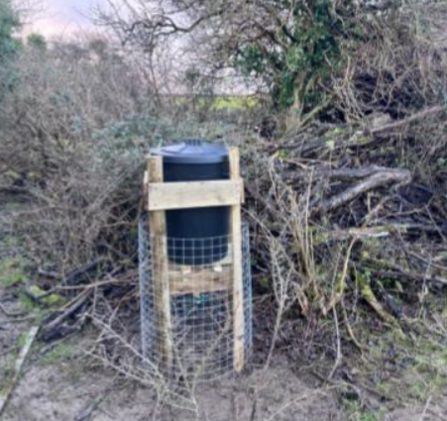
Seed Hoppers at MWT Bilown Nature Reserve
In autumn/winter of 2024/25 work again focused on Ballawhetstone where sunflower stubble and the seeds of arable wildflowers provided attraction, which was bolstered year-round via supplementary feeding of white millet using four hoppers, and, during the ‘hungry gap’ (from December) ground-scattering of white millet seed near the bases of hedgerows.
For more information on the Tree Sparrow project and how you can help visit: https://www.mwt.im/tree-sparrow
Curlew in its upland breeding habitat in Glen Rushen © Robert Fisher.
Curlew (Crottag)
Curlew are a red-listed species which has undergone significant population and range decline on the Island and is considered to be in long-term risk of extirpation as a breeding species without effective conservation measures.
Our Curlew project focused on the Southern Hills and surrounding foothills and more marginal agricultural lowlands where a viable population remains.
This population is centred on the Cross Vein area within Glen Rushen, where the DEFA Upland Ranger has long worked to boost numbers. This is likely the only area of the Island where numbers of breeding pairs has increased.
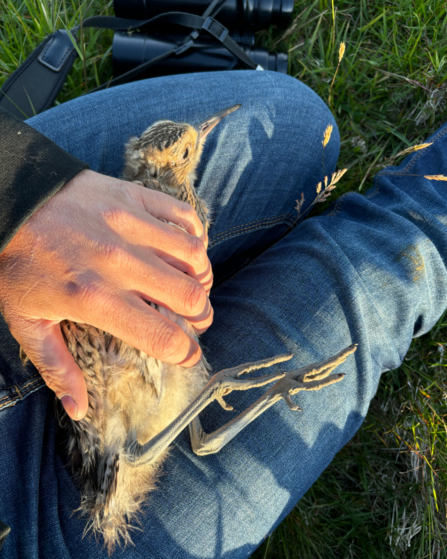
Curlew chick being ringed (under DEFA & BTO licence) on Dalby Mountain on 19/06/2024.
Aside from ‘Curlew Country’, other key remaining Curlew breeding areas included the Ayres, the lowland valleys of German and Michael parishes, upland areas within Lezayre, and generally the wetter areas of the Northern Plain, including the wet agricultural land surrounding the Ballaugh Curragh ASSI.
In total, there are 37 reported/suspected breeding areas outside of ‘Curlew Country’ that have been in use in recent years.
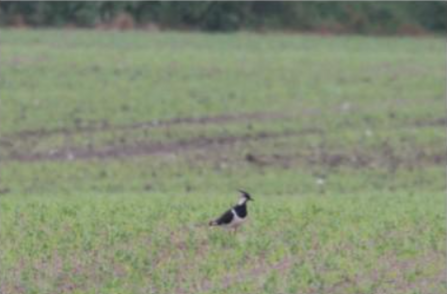
Lapwing near St Jude’s Crossroads, 27th June 2024 © Rob Fisher
Lapwing (Eairkan)
Lapwing are a red-listed, species which has undergone significant population and range decline on the Island. The last confirmed breeding attempt was in 2022 (two pairs, both failed, Kerrowmooar, Sulby). A pair of Lapwing were spotted mobbing corvids in early June near to St Jude’s by Adam Denard and Greg Watson of MWT. The site was suitable breeding habitat, with two Curlew and two Oystercatcher also noted feeding in the same field. Of note, Oystercatcher are rarely seen inland in Mann.
It is considered that this species is now either extirpated as a breeding species or, at best, functionally extinct. Migratory birds still over-winter on the Island however.
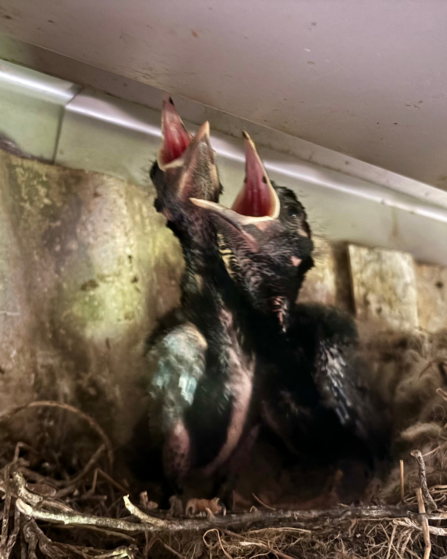
Chough (Caaig) nestlings in a modern agricultural building surrounded by their ideal foraging habitat, extensive, tightly-grazed permanent pasture.
Chough are an amber-listed, species which has undergone recent population and range expansion on the Island. The species is not considered to be in any risk of extirpation, however it is a bird of conservation importance owing to the Island supporting an internationally significant population of this species.
The Island boasts 28% of the combined UK & IOM breeding population on just 0.2% of the area. Northern Ireland lost this breeding species in 2016.
Chough naturally build their nests in caves and crevices along the rocky coast, however in recent decades here on the Isle of Man, Chough have also shown a preference for using farm buildings and inland ruins for nesting. This has also facilitated their recent colonisation of the Island’s Northern Plain.
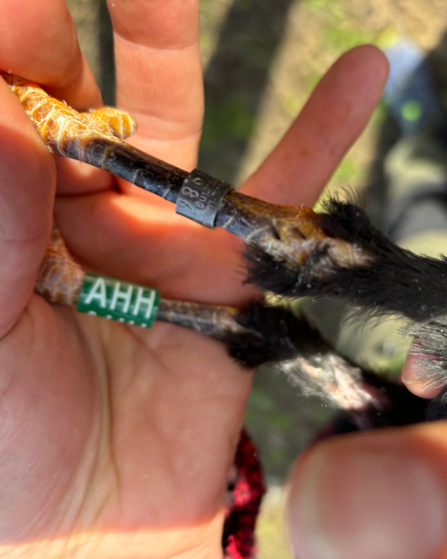
Juvenile Chough being ringed (under licence) with unique metal and colour identification rings.
Juvenile Chough being ringed (under licence) with unique metal & colour identification rings
During the 2024 breeding season, owing to the exceptionally poor weather, many Chough either did not breed at all or failed.
The Chough pairs that did breed were slightly later than usual. Five pair of Chough were monitored which nested in farm buildings in 2024, with 13 juveniles and 1 adult being fitted with a green darvic colour ring, etched with unique white font alphanumeric combinations to allow monitoring of fledgling survival and post-fledging dispersal.
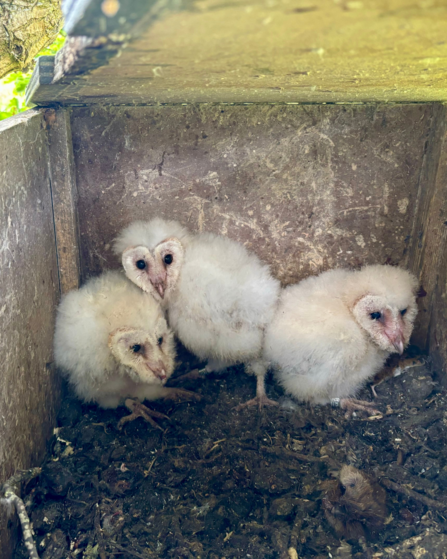
Barn Owl chicks in the nest after being ringed (under licence). Confidential site 2024 © Robert Fisher
Barn Owls are a red-listed species which has undergone population and range decline on the Island.
The Island has likely never supported a large Barn Owl population (noting the absence of their primary food, voles), however the future viability of this population remains in considerable doubt without effective conservation effort for a variety of reasons, including the widespread use of rodenticides which can kill Barn Owls through secondary poisoning.
With only around ten breeding pairs remaining Island-wide, the agricultural Northern Plain is the Manx stronghold of this species.
Records were also received from the lowland agricultural areas of German, Patrick, Marown, Santon, Rushen and Arbory parishes. Working with farmers, eight Barn Owl boxes were monitored, resulting in two breeding pairs being located. From these, seven chicks were ringed along with two adults (one from each occupied box).
Through the autumn and winter of 2024, twenty Barn Owl nest boxes (built by Robert Fisher to Barn Owl Trust specifications) have been distributed across the Island to give the species protection while roosting and breeding.
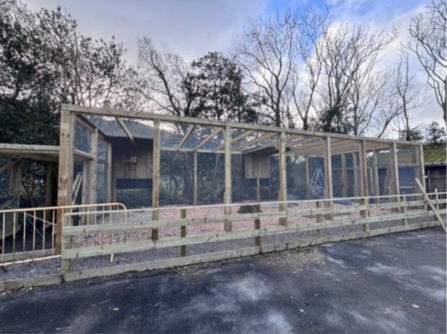
Considerable funding from the Curraghs Wildlife Park Conservation Fund has allowed us to expand our Barn Owl project here on the Island.
The start of this exciting collaboration was marked by the distribution, for free, of copies of ‘The Book Of The Barn Owl’ by Sally Coulthard to every secondary school and municipal library on the Island.
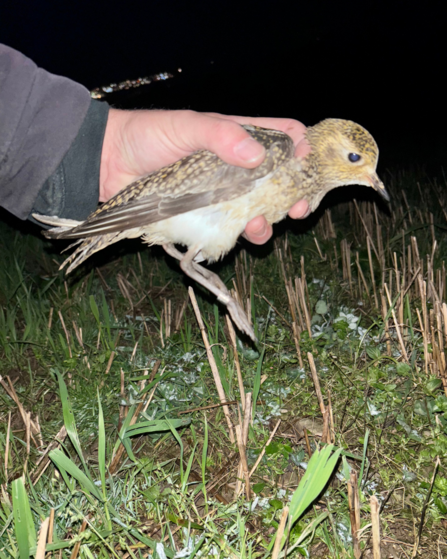
Golden Plover ringed (under DEFA & BTO licence). The first to be ringed on the Island for 20 years.
Winter Stubbles are an incredibly significant foraging (and roosting) habitat for a wide range of farmland birds including: Skylark, Meadow Pipit, Tree Sparrow, Linnet, Stock Dove, Lapwing, Woodcock, Jack Snipe, Redwing, Reed Bunting, Greenfinch, Goldfinch, Chaffinch & Golden Plover.
The amount of arable (and therefore stubble) area continues to decline on Island.
Sensitively managed winter stubbles, supported by the DEFA Agri-Environment Scheme are amongst the most important habitats to allow many farmland birds to survive the ‘hungry gap’.
While giving a Farmland by Night ringing demonstration to the Manx Ornithological Society in November 2024, two Jack Snipe were ringed along with seven red-listed Skylark. Over the autumn and winter 2024/25, 43 Skylark have been ringed on the Island’s stubble fields, helping us get a better understanding of the birds over-wintering habitat preference and total population.
After two years of targeted monitoring and active conservation of our farmland birds, we now have a better understanding of the species that are struggling the most, what they need from us, and where best to undertake specific (and often urgently required) conservation interventions. We now have a baseline knowledge of their population, distribution, requirements and habitat preferences against which to monitor our impact going forward.
At the start of 2025, we know far more about the current status of the Island’s precious and enigmatic farmland birds, which will be enhanced further during 2025 by the Manx BirdLife all-Island Chough Census later this year.
Our farmland birds are sentinels to the health of our agriculturally-dominated landscape. By all conservation organisations working effectively together, and collaborating with our farming community, it is hoped that we can prevent any further extirpations of farmland specialist species on our Island, and in time, bring about a recovery of our farmland birds through more nature-positive arable and pastoral agriculture.
With special thanks to all the generous private individuals and organisations who have so kindly funded and supported our work in 2024. Gura mie mooar ayd!
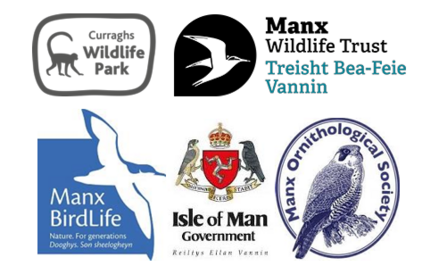
For more information visit our Farmland Bird Recovery Page
